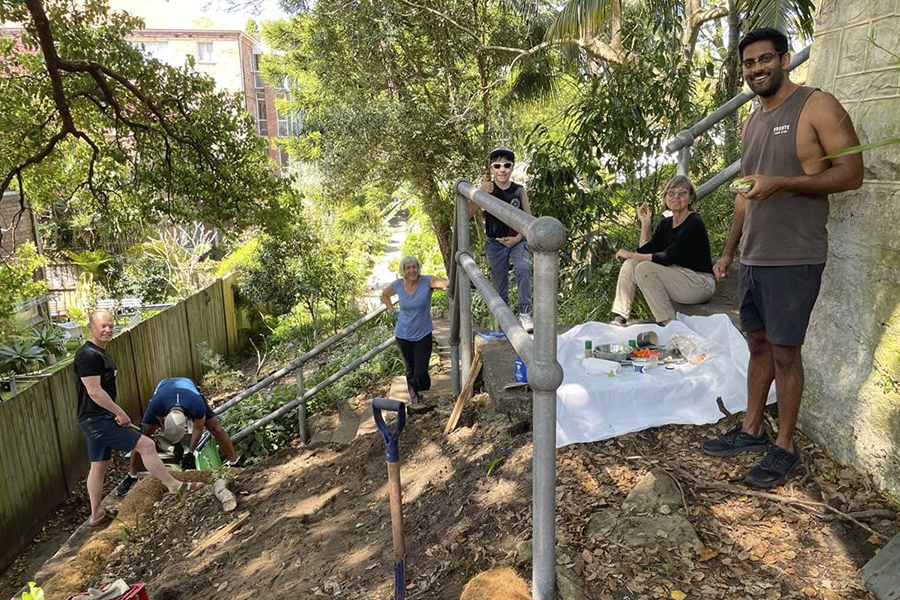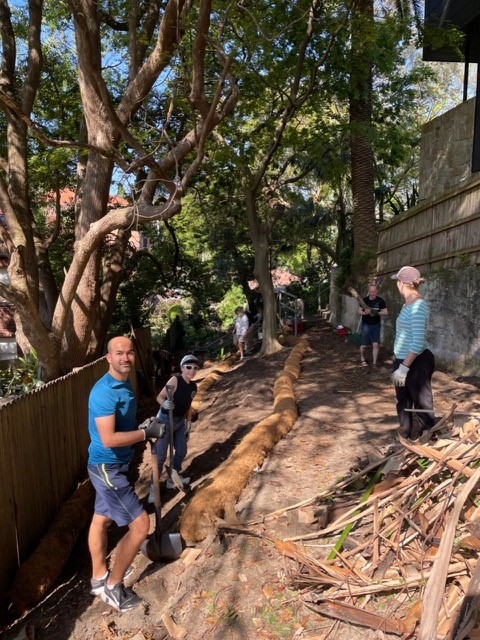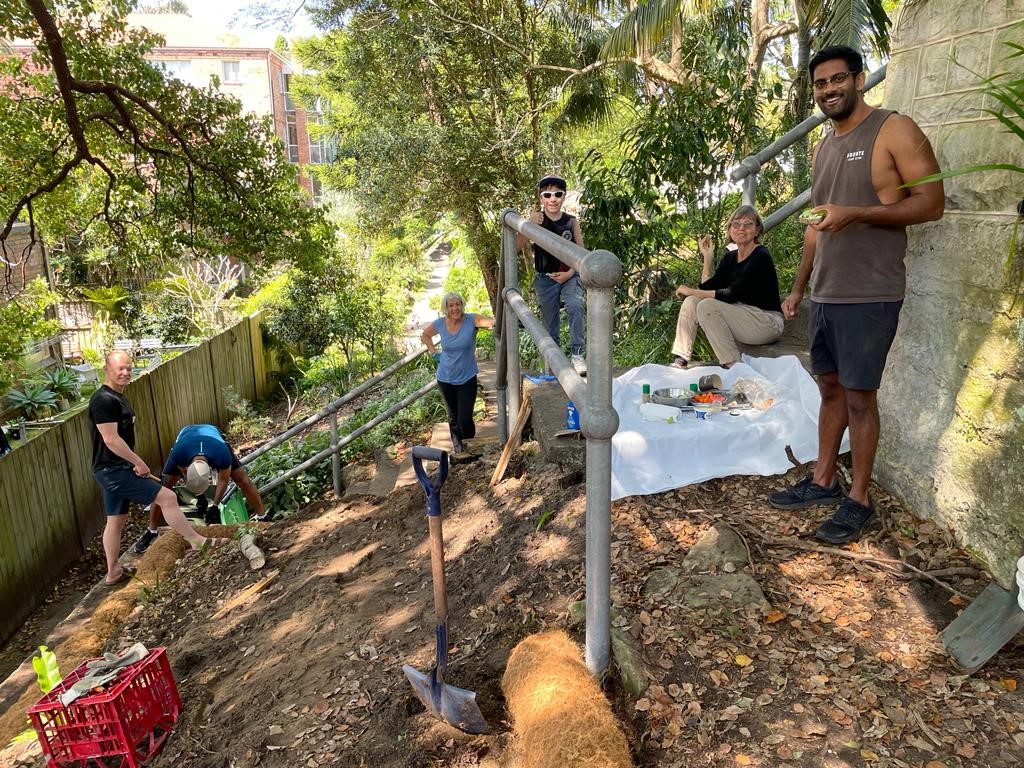Restoring the laneway
Revitalising Langlee Lane to improve habitat connectivity, safety and enjoyment
A successful shared community garden has been operating in Langlee Lane, with Council’s support, since 2011 growing vegetables and fruit, composting, worm farming and native beekeeping.
In 2022 the Langlee Lane Community Garden group, revived the unloved west section of the lane, addressing the dirt path, overgrown weeds and eroded slope. Located in a biodiversity corridor that links habitat in Bronte to Waverley Park and Queens Park, the project supports Council’s goals to enhance our urban ecosystems by improving habitat connectivity with native plants. Accessing support through Council’s Environmental Small Grants and Living Connections Program, the space has been transformed through weed removal, new native seedlings, installing coir logs to stabilise the slope and installation of stairs yet to come.
Group leaders Sandra Fox and Vanessa Power, tell us about the Laneway revitalisation journey.



Sandra: The Langlee Lane Community Garden group has managed the existing food and native garden for several years, as well as a successful community composting facility in the laneway. We are experienced gardeners and have a range of skills between us, and also have a horticulturalist to call on for information and support. We regularly consult with Randwick community nursery and Indigigrow nursery for plant advice and support.
We wanted to improve biodiversity and native habitat for small birds and insects and improve slope stability through the native plantings and we also wanted to beautify the area to increase public enjoyment of this popular walkway for the local community.
Sandra: The group researched native plants suitable for the conditions in the laneway, which has very sandy soil and is shady in parts and discussed the best way to stabilise the slope with minimal impact. We worked closely with various teams in Council, including submitting our plans in writing through Council’s Environmental Grant process and the Public Gardening coordinator.
Vanessa: Following this we consulted immediate neighbours and updated on our planning progress through our local WhatsApp gardening group. We then set about planning our Working Bees to prepare the site. There were several working bees required to prepare the site for landscaping and planting. A team of ten locals were involved in this work. We removed weeds and dug shallow trenches for the coir logs. The group was careful not to remove the weeds until the coir logs were ready to be installed, as the weeds were providing slope stability. Once installed, the coir logs effectively put a perimeter around a cleared pathway and “terraced” the slope.
Once the site was ready, we held another two working bees to plant the 150 native seedlings, water them in, and mulch the area, to help keep weeds down and enrich the soil life. Species were chosen that are endemic to our area and are adapted to local conditions and included grasses and ground covers to help stabilise the soil and low to medium shrubs, including Lomandra longifolia, Hardenbergia violacea, Hardenbergia violacea, Baeckea linifolia, Correa alba and Banksia ericifolia amongst others.
Sandra: The logs are already doing a great job. With all the rain that we’ve had they have become heavy and are holding their ground, they are already holding back runoff with soil collecting on the high side of the log.
We installed plant guards on some plants to help protect them and the new pathway that we’ve made, with coir logs on one side and recycled timber on the other, helps keep people and their dogs walking on the path and not through the garden. We also put a sign in our notice board to inform passers-by about the new plants.
Vanessa: Our gardening group will continue to hold semi-regular working bees including a weeding blitz across the rest of the garden. We will also regularly replenish the mulch to help keep the future weeds down. Hopefully we will continue to rejuvenate the remainder of Langlee Lane in stages, eventually revegetating all the way up to Brown St.
What has been your greatest challenge?
Sandra: Perhaps it’s about having enough time to do the work and gathering all the info we needed to set the garden up for success. We’re all locals with busy lives, but in saying that we all enjoy working in the garden, we just wish we had more time to do it.
Sandra: Easily the most enjoyable aspect has been how this project has brought our local community together. Even neighbours who will start by saying that they don’t know anything about gardening, but would like to get involved, quickly become part of our growing garden group. It gives us all a chance to meet new people and catch up with those we know, whilst gardening. It also gives us a sense of shared purpose to continue to care for what we have created.
Vanessa: The other big thing, is how much we love our new space. When we’re out working in the garden, many people will let us know what a difference it’s made to them also. What was a jungle of weeds and rubbish is now a burgeoning native habitat garden with a clear walking pathway. Hopefully in time it will attract more birds and insects as we provide more habitat and all that really enriches our neighbourhood space.
Sandra: Just make a start rather than putting off that garden that you’d like to get going. The Council has a lot of resources to really help you get started. Once you gain approvals and start working, you’ll be surprised how many locals will stop to ask if they can get involved or admire your work.
We’re really proud of the work we’ve done as well as the way in which building this garden has drawn out even more of the neighbours who have become involved. We really appreciate the support of Waverley Council in helping us to do this.


